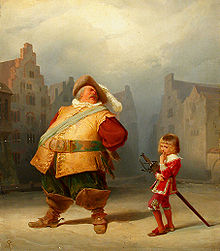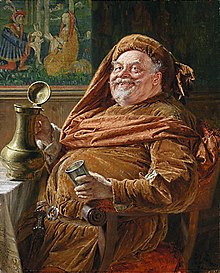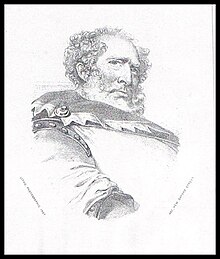John Falstaff

Sir John Falstaff is a fictional character who appears in three plays by William Shakespeare. In the two Henry IV plays, he is a companion to Prince Hal, the future King Henry V. A fat, vain, boastful, and cowardly knight, Falstaff leads the apparently wayward Prince Hal into trouble, and is ultimately repudiated after Hal becomes king. Falstaff also appears in The Merry Wives of Windsor.
Though primarily a comic figure, Falstaff still embodies a kind of depth common to Shakespeare's tricky comedy. In Act II, Scene III of Henry V, his death is described by the character "Hostess", possibly the Mistress Quickly of Henry IV, who describes his body in terms that parody Plato's description of the death of Socrates.
Appearances

He appears in the following plays:
His death is mentioned in Henry V but he has no lines, nor is it directed that he appear on stage. However, many stage and film adaptations have seen it necessary to include Falstaff for the insight he provides into King Henry V's character. The most notable examples in cinema are Laurence Olivier's 1944 version and Kenneth Branagh's 1989 film, both of which draw additional material from the Henry IV plays.
There are several works about Falstaff, inspired by Shakespeare's plays:
- Orson Welles's Chimes at Midnight (1966) compiles the two Henry IV plays into a single, condensed storyline, while adding a handful of scenes from Richard II and Henry V. The movie, also known as Falstaff, features Welles himself in the title role.
- Falstaff (1893), Giuseppe Verdi's last opera, with a libretto by Arrigo Boito. It is mostly based upon The Merry Wives of Windsor.
- Falstaff (1799), Antonio Salieri's opera, with a libretto by Carlo Prospero Defranceschi, which is also based upon The Merry Wives of Windsor.
- Falstaff (1913), a "symphonic study" by Elgar, which is a sympathetic and programmatic musical portrait.
- Falstaff, a Hungarian TV movie based on Henry IV, part 1 and Henry IV, part 2, prepared by László Vámos and Péter Müller
- Die lustigen Weiber von Windsor (1849) by Carl Otto Nicolai, based upon The Merry Wives of Windsor.
- Sir John in Love, 1924–1928, an opera by composer Ralph Vaughan Williams
- The opera Plump Jack (1984) by Gordon Getty.
- The novel Falstaff by Robert Nye.
Origins

One theory is that Shakespeare originally named Falstaff "John Oldcastle", and that Lord Cobham, a descendant of the historical John Oldcastle, complained, forcing Shakespeare to change the name. There is both textual and external evidence for this belief. In Henry IV, Part One, Falstaff's name is always unmetrical, suggesting a name change after the original composition; Prince Hal refers to Falstaff as "my old lad of the castle" in the first act of the play; the epilogue to Henry IV, Part II, moreover, explicitly disavows any connection between Falstaff and Oldcastle, a dancer declaring: "...where, for anything I know, Falstaff shall die of a sweat, unless already 'a be killed with your hard opinions; for Oldcastle died a martyr and this is not the man".[1]
The historical Oldcastle was unlike Falstaff; in particular, he was a Lollard who was executed for his beliefs, and he was respected by many Protestants as a martyr. Shakespeare knew an anonymous play of the 1580s, The Famous Victories of Henry V, in which Oldcastle is Henry V's companion, and Oldcastle's history is described in Raphael Holinshed's Chronicles, Shakespeare's usual source for his histories.
It is not clear, however, if Shakespeare characterized Falstaff as he did for dramatic purposes, or because of a specific desire to satirize Oldcastle or the Cobhams. Cobham was a common butt of veiled satire in Elizabethan popular literature; he figures in Ben Jonson's Every Man in His Humour and may have been part of the reason The Isle of Dogs was suppressed. Shakespeare's desire to burlesque a hero of early English Protestantism could indicate Catholic sympathies, but Henry Brooke, 11th Baron Cobham was sufficiently sympathetic to Catholicism that in 1603, he was imprisoned as part of the Main Plot to place Arbella Stuart on the English throne, so if Shakespeare wished to use Oldcastle to embarrass the Cobhams, he seems unlikely to have done so on religious grounds.
The Cobhams appear to have intervened while Shakespeare was in the process of writing either The Merry Wives of Windsor or the second part of Henry IV. The first part of Henry IV was probably written and performed in 1596, and the name Oldcastle had almost certainly been allowed by Master of the Revels Edmund Tilney. William Brooke, 10th Baron Cobham may have become aware of the offensive representation after a public performance; he may also have learned of it while it was being prepared for a court performance (Cobham was at that time Lord Chamberlain). As father-in-law to the newly-widowed Robert Cecil, Cobham certainly possessed the influence at court to get his complaint heard quickly. Shakespeare may have included a sly retaliation against the complaint in his play The Merry Wives of Windsor (published after the Henry IV series). In the play, the paranoid, jealous Master Ford uses the alias "Brook" to fool Falstaff, perhaps in reference to William Brooke. At any rate, The name is Falstaff in the Henry IV, part 1 quarto, of 1598, and the epilogue to the second part, published in 1600, contains this clarification:

- "One more word, I beseech you. If you be not too much cloyed with fat meat, our humble author will continue the story, with Sir John in it, and make you merry with fair Katharine of France where, for any thing I know, Falstaff shall die of a sweat, unless already a' be killed with your hard opinions; for Oldcastle died a martyr, and this is not the man."
Another theory is that the new name "Falstaff" could have been derived from the medieval knight Sir John Fastolf (who was also a Lollard). Changing a few letters gave Shakespeare the name by which his invention is known today. There was a historical Sir John Fastolf who fought at the Battle of Patay against Joan of Arc, which the English lost. Fastolf's previous actions as a soldier had earned him wide respect, but he seems to have become a scapegoat after the debacle. He was among the few English military leaders to avoid death or capture during the battle, and although there is no evidence that he acted with cowardice, he was temporarily stripped of his knighthood. Fastolf's role in Henry VI, Part I loosely follows these events.
It has been suggested that writer Robert Greene may also have been an inspiration for the character of Falstaff. This theory was first proposed in 1930 and has recently been championed by Stephen Greenblatt.[2] Notorious for a life of dissipation and debauchery somewhat similar to Falstaff, he was among the first to mention Shakespeare in his work (in Greene's Groats-Worth of Wit), suggesting to Greenblatt that the older writer may have influenced Shakespeare's characterization.
In Stratford-upon-Avon, the owners of Shrieves House, the former Three Tunns Tavern and now a museum, claim William Shakespeare based the character Falstaff on William Rogers, one of the Sargeants of the mace and close friend of the Shakespeares.[3] This was suggested in circumstantial research by Petra Rees in her book The Shrieves House.[4]
Another possibility is that more than one of these theories is correct, since writers very often base their characters on a composite of several people (real or equally fictitious) of whom they have knowledge.
Notable Falstaffs

- Stephen Kemble of the famous Kemble family at Theatre Royal, Drury Lane, London, 1802[5]
- Victor Buono at the Mark Taper Forum
- Pat Carroll at the Folger Shakespeare Library in Washington, D.C.
- Delaney Williams at the Folger Shakespeare Library
- Maurice Evans on Broadway
- Kevin Kline at Lincoln Center Theater and The Colbert Report{date=27 July 2010}
- Samuel Phelps at Sadler's Wells Theatre
- Anthony Quayle at the Shakespeare Memorial Theatre, on BBC Radio in Vivat Rex (1977) and on BBC Television (1979)
- George Robey in Laurence Olivier's Henry V
- Robbie Coltrane, in Kenneth Branagh's Henry V (1989)
- Ralph Richardson at the Old Vic Theatre
- Joss Ackland at the Old Vic and at the Barbican Theatre for the Royal Shakespeare Company
- Orson Welles in the film Chimes at Midnight
- Robert Stephens at the Royal Shakespeare Company
- Desmond Barrit at the Royal Shakespeare Company
- William Hutt at the Stratford Festival of Canada
- Douglas Campbell at the Stratford Festival of Canada
- Simon Callow at the Royal Shakespeare Company
- David Warner at the Royal Shakespeare Company
- James Keegan at the American Shakespeare Center
- Roger Allam at Shakespeare's Globe
- Frank Pettingell for the 1960 BBC TV Production Shakespeare's Age of Kings
- Simon Russell Beale at Shakespeare's Globe
- Christopher Benjamin at Shakespeare's Globe
- John Woodvine at the English Shakespeare Company
- Barry Stanton at the English Shakespeare Company
In popular culture
Volstagg, a comic book character that appears as a supporting character in Marvel Comics' version of Thor, was created as a Falstaff-type character.[6]
In a documentary chronicling the making of the first three Indiana Jones films, John Rhys-Davies stated that his character of Sallah was meant to be a cross between his character in Shogun, Portuguese Pilot Vasco Rodrigues, and Falstaff.[citation needed]
According to director Gus Van Sant, the character of Bob in My Own Private Idaho was based upon Falstaff, and the character of Scott was based on Prince Hal.[7]
See also
Notes
- ^ Online text of epilogue http://www.readbookonline.net/read/401/9681/
- ^ Baldwin Maxwell in Studies in Phiology 27(2): 230-232 (1930); Greenblatt, Will in the World: How Shakespeare Became Shakespeare (2004)
- ^ www.falstaffexperience.co.uk
- ^ http://www.falstaffexperience.co.uk/page.php?linkid=20&sublinkid=106'.
- ^ K. E. Robinson (1972). "Stephen Kemble's Management of the Theatre Royal, Newcastle upon Tyne" in Richards, K. and Thomson, P. (eds). Essays on the Eighteeenth-Century English Stage p.142
- ^ Cooke, Jon B. (Editor); Thomas, Roy (Interviewer). "Stan the Man & Roy the Boy: A Conversation Between Stan Lee and Roy Thomas ", TwoMorrows. reprinted from Comic Book Artist #2, accessed May 8, 2011.
- ^ Fuller, Graham (1993). "Gus Van Sant: Swimming Against the Current". Even Cowgirls Get the Blues and My Own Private Idaho. Faber & Faber. pp. xxv.
{{cite news}}: Cite has empty unknown parameter:|coauthors=(help)
References
- Caldwell, Ellen M. ""Banish All the Wor(l)d": Falstaff's Iconoclastic Threat to Kingship in I Henry IV." Renasence 59 (2007).
- Doloff, Steven. "FALSTAFF'S 'HONOUR': HOMERIC BURLESQUE IN 1 HENRY IV (1597-8)." Notes & Queries 55 (2008).
- Grady, Hugh. "Falstaff: Subjectivity between the Carnival and the Aesthetic." The Modern Language Review 96 (2001).
- Bloom, Harold, editor. Falstaff. New York: Chelsea House, 1992.
- Taylor, Gary. "William Shakespeare, Richard James, and the House of Cobham." Review of English Studies 58 (1987).
- Wilson, John Dover. The Fortunes of Falstaff. Cambridge: Cambridge University Press, 1943.
- Stephen Cooper The Real Falstaff (a biography of Sir John Fastolf) (Pen & Sword, 2010)
